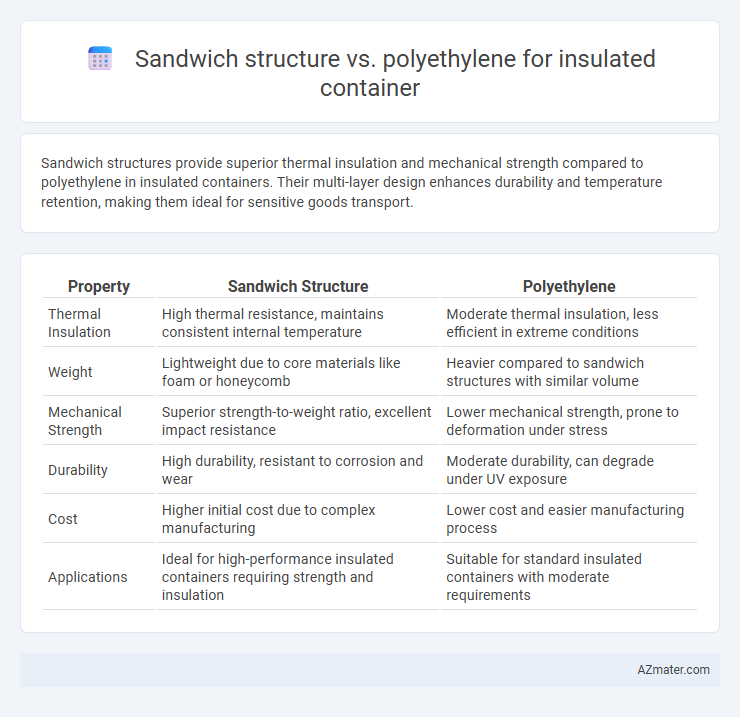Sandwich structures provide superior thermal insulation and mechanical strength compared to polyethylene in insulated containers. Their multi-layer design enhances durability and temperature retention, making them ideal for sensitive goods transport.
Table of Comparison
| Property | Sandwich Structure | Polyethylene |
|---|---|---|
| Thermal Insulation | High thermal resistance, maintains consistent internal temperature | Moderate thermal insulation, less efficient in extreme conditions |
| Weight | Lightweight due to core materials like foam or honeycomb | Heavier compared to sandwich structures with similar volume |
| Mechanical Strength | Superior strength-to-weight ratio, excellent impact resistance | Lower mechanical strength, prone to deformation under stress |
| Durability | High durability, resistant to corrosion and wear | Moderate durability, can degrade under UV exposure |
| Cost | Higher initial cost due to complex manufacturing | Lower cost and easier manufacturing process |
| Applications | Ideal for high-performance insulated containers requiring strength and insulation | Suitable for standard insulated containers with moderate requirements |
Introduction to Insulated Container Materials
Sandwich structure materials for insulated containers typically consist of two outer metal or plastic layers with a core of polyurethane or polystyrene foam, offering superior thermal insulation and mechanical strength. Polyethylene, commonly used for insulated containers, provides lightweight, moisture-resistant properties with moderate insulation performance. Selecting between sandwich structures and polyethylene depends on specific insulation requirements, durability, and cost considerations in cold chain and transport applications.
Overview of Sandwich Structure Technology
Sandwich structure technology in insulated containers utilizes a core material, often polyurethane or polystyrene foam, bonded between two rigid facings such as aluminum or fiberglass to provide superior thermal insulation and mechanical strength compared to polyethylene alone. This technology enhances energy efficiency by minimizing heat transfer and improving structural integrity, making it ideal for temperature-sensitive transportation and storage. The lightweight yet robust design of sandwich panels ensures durability and reduced thermal conductivity, outperforming traditional polyethylene containers in insulation performance.
Properties and Benefits of Polyethylene
Polyethylene offers excellent moisture resistance, chemical stability, and impact durability, making it an ideal material for insulated containers used in demanding environments. Unlike sandwich structures, polyethylene provides superior flexibility and ease of fabrication, reducing manufacturing complexity and cost. Its lightweight nature combined with high thermal insulation efficiency enhances container performance and energy savings during cold chain transportation.
Thermal Insulation Performance: A Comparative Analysis
Sandwich structures typically offer superior thermal insulation compared to polyethylene due to their multi-layer composition, which often includes insulating cores such as polyurethane or polystyrene sandwiched between high-density outer panels. Polyethylene, while lightweight and moisture-resistant, generally has lower thermal resistance, making it less effective in minimizing heat transfer in insulated containers. The enhanced insulation performance of sandwich panels translates into better temperature retention and energy efficiency in refrigerated transport and storage applications.
Strength and Durability: Sandwich Structure vs. Polyethylene
Sandwich structures exhibit superior strength and durability compared to polyethylene in insulated containers due to their multi-layer composition, which combines a rigid core with strong face sheets, enhancing load distribution and impact resistance. Polyethylene, while lightweight and corrosion-resistant, tends to have lower mechanical strength and may degrade faster under UV exposure and repeated stress. The sandwich structure's enhanced rigidity and long-term durability make it a preferred choice for applications requiring robust insulation and sustained performance.
Weight and Design Flexibility
Sandwich structures offer superior weight reduction compared to traditional polyethylene, enhancing portability and fuel efficiency in insulated containers. Their multi-layer composition allows for tailored mechanical properties and improved thermal insulation without adding bulk. Polyethylene's design flexibility is limited by its homogeneous nature, whereas sandwich structures enable complex shapes and optimized core materials for specific insulation and structural requirements.
Cost Effectiveness and Manufacturing Considerations
Sandwich structures offer enhanced thermal insulation and mechanical strength compared to polyethylene, making them cost-effective by reducing energy consumption for temperature control in insulated containers. Manufacturing considerations favor sandwich panels due to their customizable core materials and thickness, which allow precise tailoring to specific insulation requirements, unlike polyethylene's uniform properties. Despite higher initial material costs, sandwich structures often lower lifetime expenses through durability and reduced maintenance needs in insulated container applications.
Environmental Impact and Recyclability
Sandwich structures, typically composed of a core material like foam between two rigid facings, offer superior insulation with potentially lower material usage, reducing environmental impact compared to solid polyethylene containers. Polyethylene, while widely recyclable, poses challenges due to difficulties in sorting and contamination, often leading to downcycling or landfill disposal. The recyclability of sandwich structures is limited by the composite nature of materials, complicating separation and reducing the efficiency of recycling processes.
Application Suitability: Which Material for Which Use?
Sandwich structures excel in insulated container applications requiring high structural strength and thermal insulation, often used in cold chain logistics for pharmaceuticals and perishable goods. Polyethylene offers flexibility, impact resistance, and moisture barrier properties, making it suitable for lightweight insulation needs and reusable food storage containers. Choosing between these materials depends on factors like load-bearing requirements, thermal performance, and durability in specific transport or storage environments.
Summary: Key Takeaways for Insulated Container Design
Sandwich structures offer superior thermal insulation and mechanical strength compared to polyethylene in insulated container design, enhancing energy efficiency and durability. Polyethylene provides cost-effective, lightweight solutions but often lacks the insulation performance and structural rigidity required for extreme temperature control. Selecting sandwich structures with high-performance core materials can significantly improve thermal resistance and impact resilience, making them ideal for advanced insulated container applications.

Infographic: Sandwich structure vs Polyethylene for Insulated container
 azmater.com
azmater.com